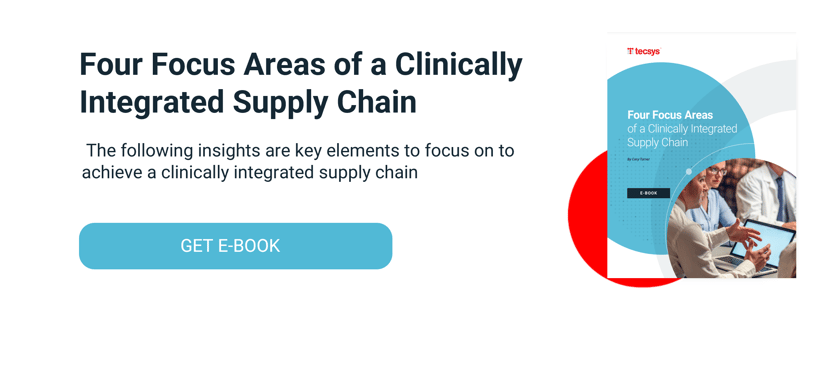Top 5 Reasons for a Single Supply Chain Platform

A new report from Kaufman Hall reveals 99% of U.S. healthcare organizations surveyed are experiencing challenges in supply procurement, recommending that supply chain staff have “full responsibility for inventory management so clinical staff can focus their energy on delivering patient care.”
Today, most clinical areas use disjointed, bolt-on systems for inventory management that are disconnected from the IDN or hospital’s electronic health record (EHR) and enterprise resource planning (ERP) systems. Not only are they time-consuming and labor-intensive for clinicians to use, but they leave supply chains in the dark on the status of the highest cost, most critical items.
Healthcare organizations are increasingly moving to a single supply chain platform for items across all clinical areas as a way for the supply chain to truly assume full responsibility for inventory management, alleviate clinicians of this burden and provide better support care delivery.
Here are the five biggest advantages of shifting to one supply chain platform, including proof points from organizations that have taken this approach.
Top 5 Reasons for a Single Supply Chain Platform
1. Optimized Inventory Visibility
This should be the top priority for every healthcare supply chain leader. Supply chains can’t meet the objectives of the C-suite — higher care quality, lower costs, improved outcomes — if they are blind to what clinical stakeholders are buying and using in terms of medical/surgical and drug supplies.
Optimized inventory visibility refers to the ability of a supply chain platform to have real-time, immediate access to inventory throughout the enterprise — from high-volume, low-cost supplies in the nursing units, to high-cost, high-risk supplies in perioperative and the cath/IR labs, and even breaking through the long-standing walls that have shielded access to pharmaceutical inventory. An enterprise-wide supply chain management (SCM) system provides this level of visibility from point of product receipt to the point of use (POU).
Case in point: Concord Hospital returned more than 5,800 hours in clinical time and decreased $150K of wasted stock in one year.
2. Real-time Data Is Accessible and Connected Everywhere
When clinical areas rely on disconnected systems to manage supplies in silos, the supply chain and clinicians are constantly in reactive mode. Because it takes time and effort to integrate this data and make it actionable, they are basing decisions on outdated information.
Conversely, a single supply chain platform provides real-time access to inventory status across the organization. With accurate and timely data, supply chain and clinical teams have the power to be proactive with supply management. They can immediately see what items they have in stock, what requires reordering and how they can shift assets to areas of need.
Case in point: North Mississippi Health Services increased its fill rate by up to 99.98% and reduced backorders by 59%.
3. Case Costing and Forecasting Accuracy
An IDN or hospital can’t determine the total cost of care per case or procedure without visibility to supply utilization. Clinical areas relying on outdated systems where they must key in product data or scan barcodes often miss documentation of supplies in the EHR. With a fully automated and consolidated SCM, featuring automatic data capture (e.g., RFID), healthcare organizations can increase charge capture and revenue for reimbursable supplies.
With access to consumption data through a single supply chain platform, the team can perform accurate forecasting and demand planning. Rather than making assumptions based on erroneous data or hunches, the team can take a visionary, strategic approach to inventory planning guided by reliable, real-world information.
Case in point: Munson Healthcare reduced expired inventory by more than $250K per year.
4. Financial Savings Across the Health System
Supply chain leaders today are increasingly playing a key role in the operational, clinical and financial success of their organizations, tasked with determining how product choices impact care cost, quality and overall financial outcomes. A single supply chain platform provides the collective insights to evaluate product performance, implement change and measure effectiveness.
Data on product purchases and utilization support supply standardization initiatives. When that data is tied to clinical outcomes, it can be used to evaluate how supplies consumed in a case impacted care quality. The integration of product usage, clinical and financial data (e.g., billing and reimbursement) presents the complete cost, quality and outcomes (CQO) picture required to achieve meaningful financial savings and protect profit margins.
Case in point: Parkview Health reclaimed over $17M of uncharged supplies to become billable items.
5. Enhanced Clinical Communication and Collaboration
The supply chain procures and manages supplies; clinicians use the supplies. The only way for significant change to happen is for both parties to come together, share information and collaborate on initiatives to improve care delivery.
Having complete inventory visibility using a single supply chain platform, including reliable and credible data on their cost and utilization, enables clinical and supply chain teams to determine what works/doesn’t work from a supply perspective in terms of cost and quality, and make mutual decisions for the benefit of patients. This clinically integrated supply chain (CISC) has become the new model for supply chain decisions across a growing number of IDNs and hospitals.
Case in point: Mercy reduced serious, reportable events by 71% and increased clinician satisfaction by 37%.
Simplify and Streamline Your Supply Chain Platform
Designed to improve inventory management, a single supply chain platform provides end-to-end visibility of all inventory assets across a health system or hospital’s supply chain network. With it, healthcare organizations can rely on connected clinical areas and supply chain systems have a way to track supply management with accurate data for improved patient safety.




